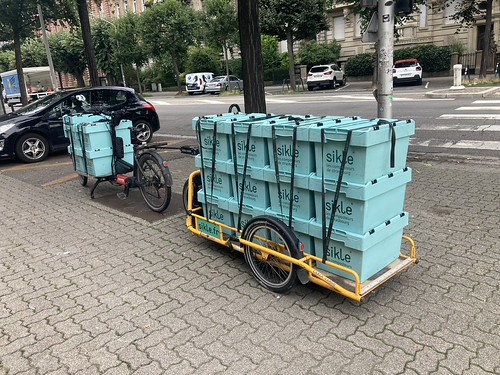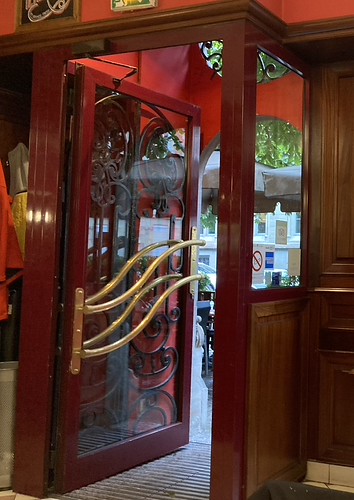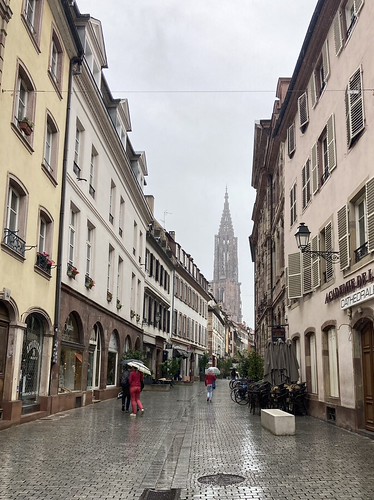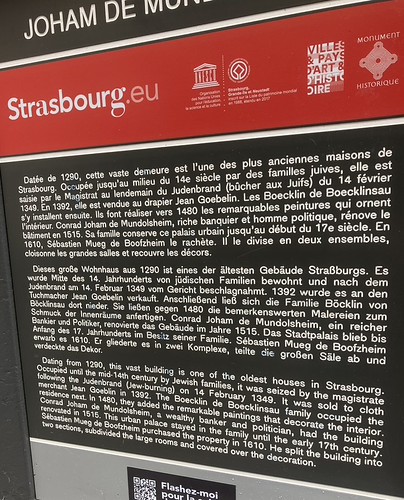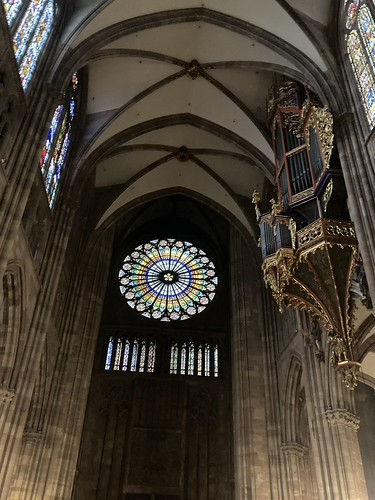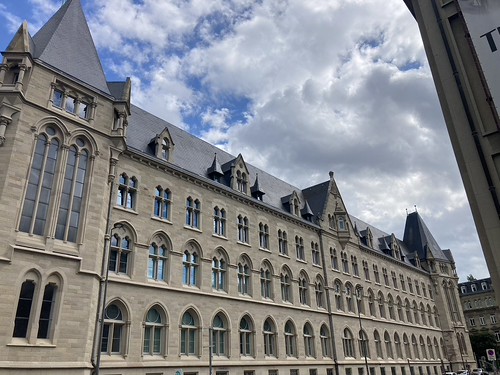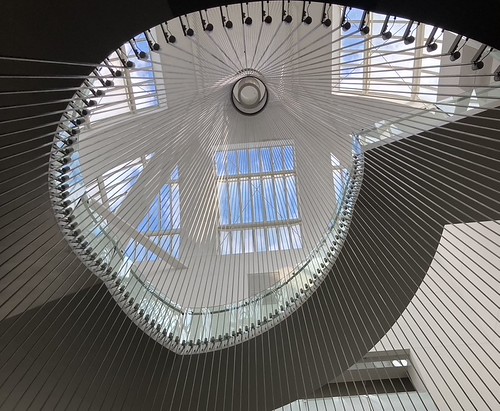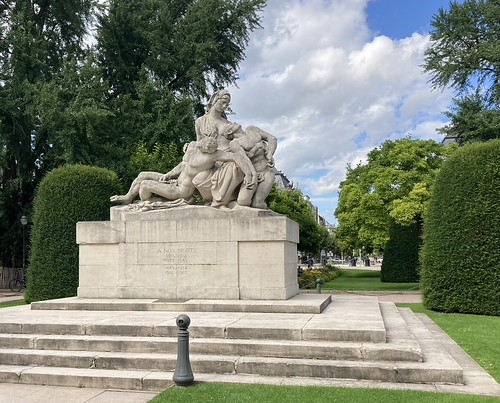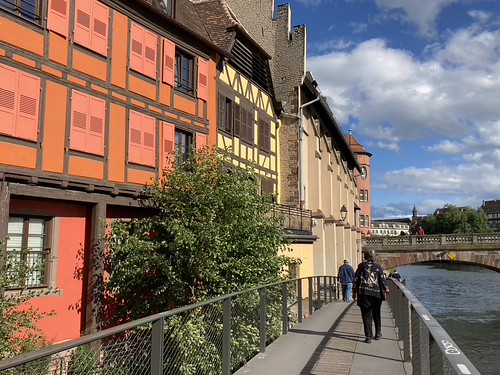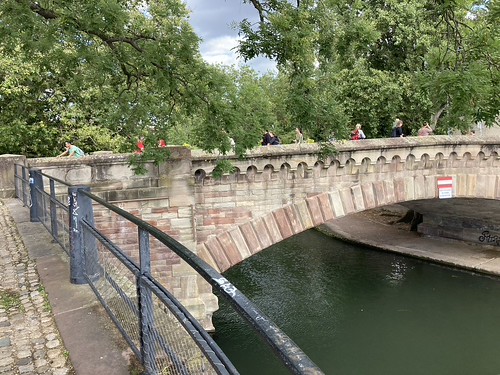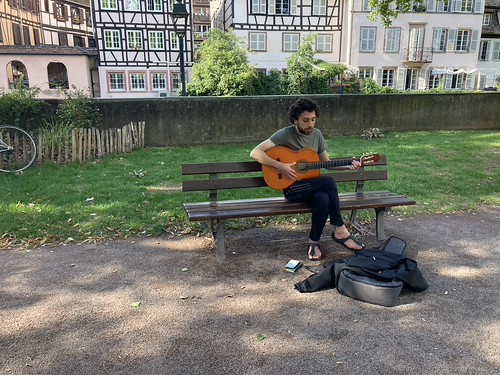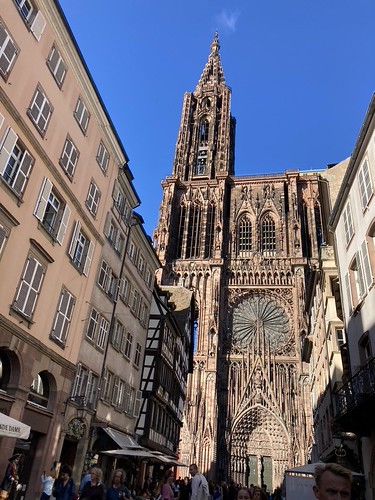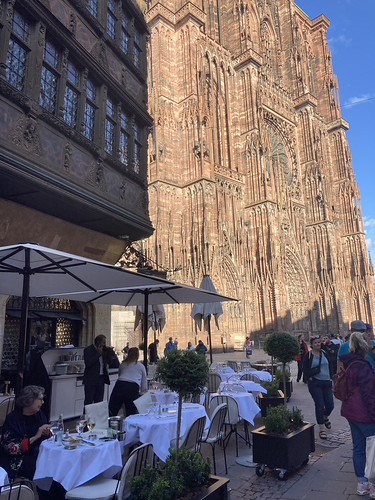Strasbourg–August 1
Facing the next day meant a shift of role back to tourist from that of honored guest and time traveler. Nevertheless Jan and I both had earlier associations with this City that added dimension to the brief visit we’d planned. My father’s birth in 1907 was registered there–perhaps because Kehl had no hospital at the time. After the Franco Prussian war in 1870, it was annexed to Germany, along with the rest of Alsace-Lorraine, before being returned to France at the end of the World War I, then reconquered by the Germans in 1939, then again becoming French in 1945.
Jan remembered hitchhiking with a friend from Stuttgart to visit the Cathedral and medieval art masterpieces in the surrounding area during her 1965 year abroad. I recalled roaming its docks until I found work on a boat that would take me down the Rhine to Brussels without being able to pay passage near the end of my three months’ summer adventure in 1962.
At the entrance of the hotel we were impressed with a parked bicycle transport for boxes of organic waste for composting, of special interest to Jan as President of San Luis Obispo’s Integrated Waste Management Authority.
We walked through the canal-side park on the cross street
and found a neighborhood coffee shop a notch above even Paul.
Umbrellas up, we headed for the Old Town, beckoned through narrow streets by the Cathedral spire,
on the way passing signage in three languages highlighting history of the City’s Jewish population, their status alternating between prominence and persecution back to the 13th century.
In the central square, we admired the 15 th century Haus Kammerzell
before entering the Cathedral, a world-reknowned attraction built between 1015 and 1439, almost demolished by French Revolutionaries in 1794, cherished as a prize by Hitler after the 1940 Nazi invasion, and damaged by Allied bombing in 1944.
Celebrated now as a Unesco World Heritage Site, restoration and renovation projects continue as they have for a millenium.
As the skies cleared, midday fatigue set in, and we walked back to Regent Contades picking up lunch groceries on the way.
Refreshed by naps and drawn by a succession of impressive buildings, we set back out up the Avenue de la Liberte. This was the central thoroughfare of the district known by its German name, “Neustadt,” or “new town,” also called the “German Imperial District” and included in the Unesco World Heritage Site designation. Built by its conquerors from across the Rhine the massive development here, like that of Victorian London, was financed by late nineteenth century industrial expansion and colonial exploitation. Under the leadership of Otto von Bismarck it was intended to show the world, and especially the French, the power and good taste of the newly consolidated German state, guided by the same principle of urban layout carried out earlier in Paris by Baron Haussman.
We walked along the endless facade of the Post Office. The style was reminiscent of London’s St. Pancras, but to me the contrast was instructive. Rather than pursue Gothic busyness to absurd elaboration, the architect here used medieval elements from the Cathedral to complement the pure functionality of a modern government bureaucracy.
At the next corner, we approached the building whose glass dome we’d seen glowing in the sunset on the evening of our arrival.
I found the combined formality and grace of its neo-Italian Renaissance style very appealing, perhaps because it reminded me of the New York Metropolitan Museum and Public Library I frequented in youth.
Crossing the boulevard at the next corner we learned that this building is also a library–the BNU or Bibliothèque nationale et universitaire.
Upon entering through the heavy facade of columns and cornices, we were startled by a diaphanous stairway spiraling toward the top of the dome which flooded the whole interior with bright white light.
Back outdoors we walked through manicured gardens down the central promenade of the magnificent Place de la Republique, originally named Kaiserplatz, or Emperor’s Plaza, toward the former Kaiserpalast, (Imperial Palace), now the home of the Central Commission for Navigation on the Rhine.
marvelling on the way at the enormous and beautifully pruned Gingko tree rising from the lawn.
At the center of the promenade, at the focus of wide vistas in four directions, we encountered The Monument to the Dead of Strasbourg, portraying a mother in the pose of Michaelangelo’s Pieta cradling two rather than one dead child.
Erected in 1936, after the first world war but still before the second, the statue represented grief for casualties of wars between Germany and France. Strasbourg’s distinction in embodying the Continental proclivity for repeated bloodshed between neighbors was a factor in its selection as the home of the European Parliament in 1948.
Looking back through the Plaza, the monumental buildings at the entrance of the University of Strasbourg came into view, closing the other end of Avenue de la Liberte. It too was built by the Germans.
Ready for more wonders, we boarded a tram for the short ride back to the Old Town or “La Grande Isle,” called that because it’s surrounded by an ancient network of canals.
Wandering beside antique houses,
through intriguing waterworks
across elegant bridges
along park-embellished banks
among happy-looking people
we eventually craved rest and food, fortunately not far from the cathedral, now dazzling in early evening light.
Despite the price, we sat down for dinner at the Haus Kammerzell, capping a sadly abbreviated stay in this magnificent City.

